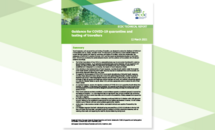Guidance for COVID-19 quarantine and testing of travellers
This document provides guidance based on scientific evidence regarding quarantine and testing of travellers in EU/EEA countries in the context of the emergence of SARS-CoV-2 variants of concern (VOCs). It follows the provisions of the Council Recommendation (EU) 2021/119 of 1 February 2021 amending Recommendation (EU) 2020/1475 on a coordinated approach to the restriction of free movement in response to the COVID-19 pandemic.
Executive summary
Travel measures, such as quarantine and testing of travellers, are designed to reduce the likelihood of SARS-CoV-2 transmission prior to, during, and after travel. This document summarises the current scientific evidence to support decision-making with regard to quarantine and testing of travellers, taking into consideration the emergence of SARS-CoV-2 variants of concern (VOC) and the current epidemiological situation in the EU/EEA. ECDC will continue monitoring the epidemiological situation and this guidance will be updated with all relevant evidence accordingly.
- The further transmission of new VOCs to a geographical area may to some extent be delayed by reducing the movement of people - i.e. by reducing non-essential travel. Travel measures, such as quarantine and testing, can help to further delay the importation and spread of the virus. However, once a VOC is established and widespread in a community, the impact of travel measures is limited.
- When deciding on the implementation of travel measures, countries should carefully weigh the expected public health benefit against the public health resources required to implement them and the socially and economically disruptive effects they may cause.
- To respond to the emergence of VOCs, ECDC recommends strengthening of all public health measures, including those relevant to travel, taking into account the epidemiological situation at both the points of departure and arrival. These strengthened measures should remain in place until very high vaccination coverage of high-risk groups and healthcare workers has been achieved, and sufficient sequencing capacity is in place for Member States to rapidly detect VOCs and take appropriate action to reduce the risk of their further spread.
- As a general measure, anyone who develops symptoms of COVID-19 or is in quarantine should refrain from travelling. In addition, at this stage of the pandemic, non-essential travel should be avoided as part of the non-pharmaceutical interventions (NPIs) designed to prevent crowding and delay the introduction and/or spread of VOCs.
- When travel measures are being considered, current evidence supports a combined approach to quarantine and testing of travellers - i.e. a pre-departure test (or test directly upon arrival) combined with quarantine and a further test five to seven days after arrival to confirm the possibility of being released from quarantine if the test is negative.
- For individuals that have recovered from a laboratory-confirmed SARS-CoV-2 infection within 180 days prior to travel, it can be considered to ease quarantine and testing requirements. However, it is still unclear whether a prior infection with one variant protects against other variants.
- At this stage, it also remains uncertain whether vaccinated individuals are capable of transmitting the infection.
- It is therefore important that both individuals having recovered from a COVID-19 infection in the last 180 days and those who have been vaccinated continue to adhere to all other preventive measures, such as wearing a face mask and respecting the need for physical distancing during travel.
Download








